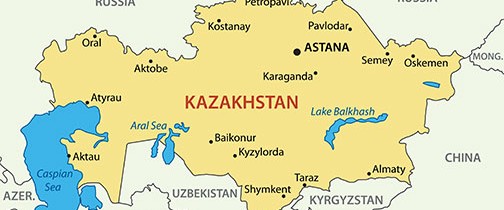Emerging Markets – Opportunities & Threats: Kazakhstan
by Sterling J. Scott, Marketing Communications Coordinator, MHI | @mhi_sterling
Opportunities
Kazakhstan has the largest economy in Central Asia with very strong oil and gas industries and a powerhouse mining industry fueled by strong uranium production. Kazakhstan produced 38% of the world’s uranium in 2013 and has over 10% of the world’s uranium resources. The country also has energy deals with Russia, India, and China – three of the BRICS countries.
An upper-middle-income country with a per capita GDP of $13,000, Kazakhstan achieved 5% and 6% economic growth in 2012 and 2013 respectively. The growth from natural resources has the potential to allow the country to invest in its institutions and infrastructure, which would result in higher quality human capital.
As an emerging market, the country may soon have investment potential reminiscent of the BRICS (Brazil, Russia, India, China and South Africa) nations, where international firms have tapped into the wealth generated. They have done so through retail and information technology development to serve the growing consumer populations that have experienced increases in buying power. There is potential in Kazakhstan’s robust oil and gas and mineral industries as well as in the emerging retail markets. More and more firms are taking notice.
Threats
Just as there are plenty of opportunities in the emerging market of Kazakhstan, there are also threats. Firms with interests in Kazakhstan should be following the Crimean Crisis closely. Kazakhstan shares half of its borders with Russia. With Russian forces occupying the Ukraine within a decade of having warred with another neighbor, Georgia, firms with interests in Kazakhstan, a substantially more strategic country, should be watching closely. While Kazakhstan did sign up to join the proposed Eurasian Union proposed by Russia, any internal conflict near the northern border with Russia has the potential to provoke Russian intrusion.
A Russian incursion into Kazakhstan would threaten the flow of natural resources from the country by slowing or halting production. Also at stake is control over the country’s oil/gas and mineral resources. Successful or not, the effects of a Russian aggression Kazakhstan would ripple throughout the global markets, especially in supply chains.
Firms also face the risk of the ever-looming resource curse, where countries with economies fueled by natural resources face limited growth by failing to diversify and becoming dependent on commodity prices. The potential failure to distribute wealth is another risk. Kazakhstan could continue to grow in wealth while the population has little to no access to it, as the country can fail to develop its institutions and infrastructure leading to weaker human capital, less jobs, income, and buying power, and a weak consumer market.
Conclusion
Interested firms should invest in researching Kazakhstan’s business potential within their industries as well as develop supply chain strategies to support continued economic growth and a possible increase in consumerism. The research and strategies should incorporate supply chain analytics, the use of innovative technologies, and lessons in human capital development that call for a mergence of employee traditional supply chain knowledge with technological competence and capability.
More information on supply chain trends, recommended strategy, and innovations that drive supply chains are available in the 2014 MHI Annual Industry Report which can be downloaded at www.mhi.org.





